Photo

Plaque with Hope, 1160, Art Institute of Chicago: Arms, Armor, Medieval, and Renaissance
Kate S. Buckingham Endowment
Size: 5.4 × 5.4 cm (2 1/8 × 2 1/8 in.)
Medium: Gilt copper, champlevé enamel
https://www.artic.edu/artworks/46263/
34 notes
·
View notes
Photo

Gauntlet for the Left Hand, Lucio Piccinino, 1565, Art Institute of Chicago: Arms, Armor, Medieval, and Renaissance
Intended purely for spectacle, parade armor represented the pinnacle of the armorer’s art. This fragmentary gauntlet for the right hand was part of such a harness. The workshop of Lucio Piccinino produced several similar commissions for various dukes and princes of the Habsburg court. The work of several craftsmen, this gauntlet merges the arts of armoring and goldsmithing. Here the technique of gold-and-silver overlay is combined with embossing—pushing the thin steel from both inside and out. With its riot of classical ornament, including grotesque figures, fruit garlands, and trophies of arms, the decoration reflects the prevailing artistic taste, known as Mannerism, at the end of the 16th century. George F. Harding Collection
Size: 16.5 × 14.6 × 19.7 cm (6 1/2 × 5 3/4 × 7 3/4 in.) Wt. 11 oz.
Medium: Steel, gold, silver, and brass
https://www.artic.edu/artworks/116446/
63 notes
·
View notes
Photo
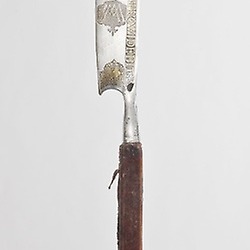
Glaive for the Bodyguard of Emperor Maximilian II, Jörg Hopfer, 1564, Art Institute of Chicago: Arms, Armor, Medieval, and Renaissance
Pole arms (staff weapons) were used not only in warfare and hunting, but also in sporting combat and ceremonies. The term refers to a family of edged weapons attached to wooden staffs. With the exception of the lance, which remained the weapon of the mounted knight, all other staff weapons were wielded by men on foot by 1600. With the development of firearms and their introduction as infantry weapons, pole arms lost their importance on the field, and from the mid-16th century, they were reserved for use in sporting contests and by princely bodyguards for ceremony and parade. The blades lent themselves to embellishment—engraving, etching, or other forms of decoration—and provided a perfect surface for the coats of arms of noble or princely families. The ceremonial use of staff weapons continues to this day with the Swiss Guards at the Vatican and Britain’s Yeomen of the Royal Guard. George F. Harding Collection
Size: L. 215.9 cm (85 in.) Blade with socket L. 62.6 cm (24 5/8 in.) Wt. 5 lb. 4 oz.
Medium: Steel, iron, gilding, oak, and silk textile (velvet)
https://www.artic.edu/artworks/106511/
43 notes
·
View notes
Photo

Wheellock from a Rifle, 1670, Art Institute of Chicago: Arms, Armor, Medieval, and Renaissance
George F. Harding Collection
Size: L. 33 cm (13 in.)
Medium: Steel
https://www.artic.edu/artworks/116779/
14 notes
·
View notes
Photo
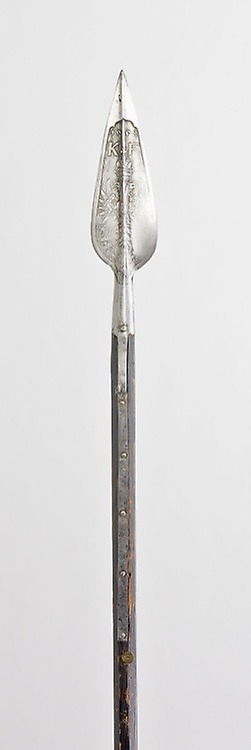
Spear for the Bodyguard of Emperor Ferdinand I, 1558, Art Institute of Chicago: Arms, Armor, Medieval, and Renaissance
George F. Harding Collection
Size: Blade L. 34.3 cm (13 1/2 in.) Wt. 3 lb. 7 oz.
Medium: Steel, iron, and wood
https://www.artic.edu/artworks/106514/
43 notes
·
View notes
Photo
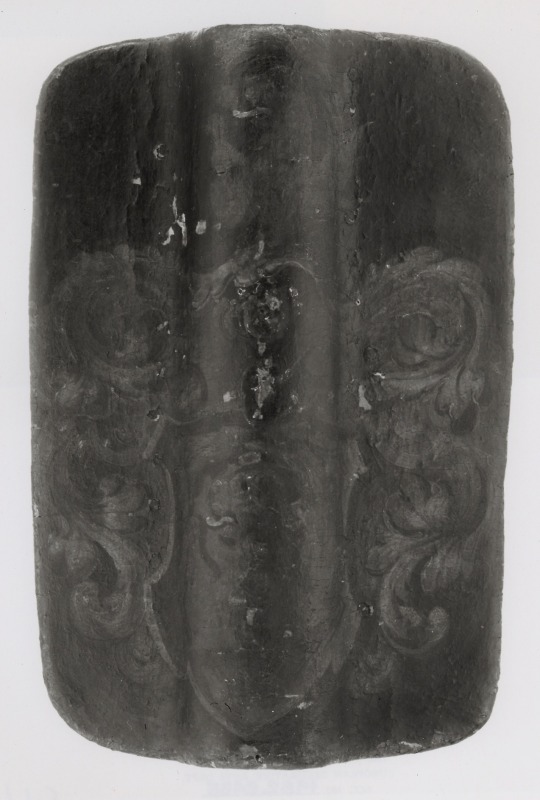
Hand Pavise, 1450, Art Institute of Chicago: Arms, Armor, Medieval, and Renaissance
George F. Harding Collection
Size: 65.9 x 43.2 cm (26 x 17 in.) Wt. 10 lb. 7 oz.
Medium: Wood, canvas, leather, paint, and gesso
https://www.artic.edu/artworks/112051/
24 notes
·
View notes
Photo

Sword of Justice, 1660, Art Institute of Chicago: Arms, Armor, Medieval, and Renaissance
George F. Harding Collection
Size: Overall L. 105 cm (41 5/16 in.) Blade L. 82.5 cm (32 1/2 in.) Wt. 4 lb. 3 oz.
Medium: Wood, sharkskin, and brass
https://www.artic.edu/artworks/117088/
2K notes
·
View notes
Photo

Sword Pommel, 1600, Art Institute of Chicago: Arms, Armor, Medieval, and Renaissance
George F. Harding Collection
Size: Overall
Medium: Iron
https://www.artic.edu/artworks/117026/
16 notes
·
View notes
Photo
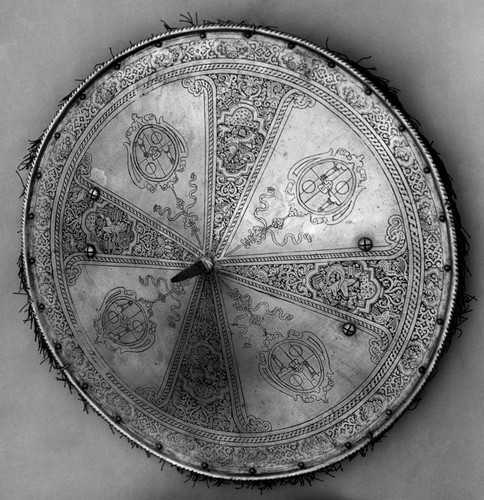
Shield, ca. 1570–80, Metropolitan Museum of Art: Arms and Armor
Gift of William H. Riggs, 1913
Size: Diam. 21 ¾ in. (55.2 cm); D. 7 3/8 in. (18.7 cm); Wt. 8 lb. 10.4 oz. (3923.6 g)
Medium: Steel, textile
https://www.metmuseum.org/art/collection/search/27247
143 notes
·
View notes
Photo
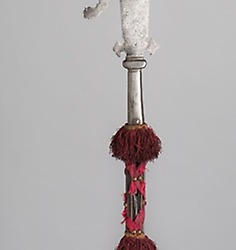
Glaive for the Civic Guard of Rome, 1590, Art Institute of Chicago: Arms, Armor, Medieval, and Renaissance
George F. Harding Collection
Size: Blade with socket L. 86.3 cm (34 in.) Wt. 6 lb. 11 oz. [measure for overall length]
Medium: Steel, wood, and modern tassel
https://www.artic.edu/artworks/116277/
29 notes
·
View notes
Photo

Bevor with two Gorget Plates, 1450, Art Institute of Chicago: Arms, Armor, Medieval, and Renaissance
George F. Harding Collection
Medium: Steel
https://www.artic.edu/artworks/112126/
13 notes
·
View notes
Photo
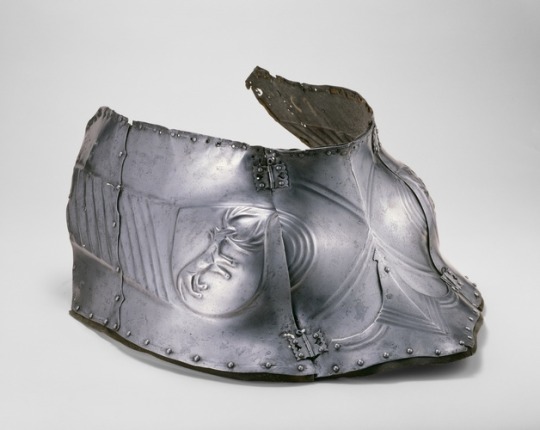
Peytral from a horse armor of Georg von Wolframsdorf, Christian Spor, 1475, Art Institute of Chicago: Arms, Armor, Medieval, and Renaissance
George F. Harding Collection
Size: L. 66 cm (26 in.) Weight: 8 lbs.
Medium: Steel and leather
https://www.artic.edu/artworks/111759/
21 notes
·
View notes
Photo

Saint Anthony Abbot, Fra Angelico, 1440, Art Institute of Chicago: Arms, Armor, Medieval, and Renaissance
Trained initially as an illuminator, Fra Angelico became a Dominican friar early in his successful career as a painter. This panel was almost certainly once part of the major altarpiece that he painted shortly after 1440 for the high altar of the church of the Dominican convent of San Marco in Florence, a work commissioned by Cosimo de’ Medici. Dismantled by the early 19th century, Fra Angelico’s altarpiece had as its focal point a large central panel representing the Virgin and Child with saints; below this a predella featured episodes from the lives of the Medici patrons, Saints Cosmas (Cosimo’s namesake) and Damian. At the sides, set into the uprights of the frame, were 10 separate saints standing on clouds. Saint Anthony Abbot would have been one of these; a fourth-century Egyptian hermit, the saint was considered the founder of monasticism. Bequest of Elizabeth Iglehart Blair
Size: 39.4 × 14.0 cm (15 1/2 × 5 1/2 in.)
Medium: Tempera on panel
https://www.artic.edu/artworks/129756/
18 notes
·
View notes
Photo

Composite Dagger, 1500, Art Institute of Chicago: Arms, Armor, Medieval, and Renaissance
George F. Harding Collection
Size: L. 47.9 cm (18 3/4 in.) Blade L. 33 cm (13 in.) Wt. 15 oz
Medium: Nephrite, bloodstone, turquoise, gold, and copper alloy
https://www.artic.edu/artworks/117044/
1K notes
·
View notes
Photo

Quiver for Crossbow Bolts, 1460, Art Institute of Chicago: Arms, Armor, Medieval, and Renaissance
Used to carry and store crossbow bolts (arrows), very few bolt quivers survive from the fifteenth century. This rare example is covered in the hairy hide of a boar or domestic pig, used as a hard-wearing, water-resistant covering over a wooden core. Much of the stiff bristly hair has now worn off but originally covered the entire quiver. Period paintings and illustrations show what such quivers originally looked like, for example, the crossbowman in the foreground of Christ Carrying the Cross wears one hung from his belt. George F. Harding Collection
Size: L. 40.6 cm (16 in.)
Medium: Wood, leather, and boar skin
https://www.artic.edu/artworks/116851/
19 notes
·
View notes
Photo

Partisan, 1600, Art Institute of Chicago: Arms, Armor, Medieval, and Renaissance
George F. Harding Collection
Size: Blade with socket L. 71.1 cm (28 in.) Wt. 4 lb. 10 oz. [measure for overall length]
Medium: Steel, wood, cloth, brass, and cotton tassels
https://www.artic.edu/artworks/116253/
21 notes
·
View notes
Photo

Stone Crossbow with Spanner for a Child, 1690, Art Institute of Chicago: Arms, Armor, Medieval, and Renaissance
George F. Harding Collection
Size: 8.3 x 47 x 31.1 cm (3 1/4 x 18 1/2 x 12 1/4 in.)
Medium: Wood, bone, and fiber
https://www.artic.edu/artworks/116866/
129 notes
·
View notes